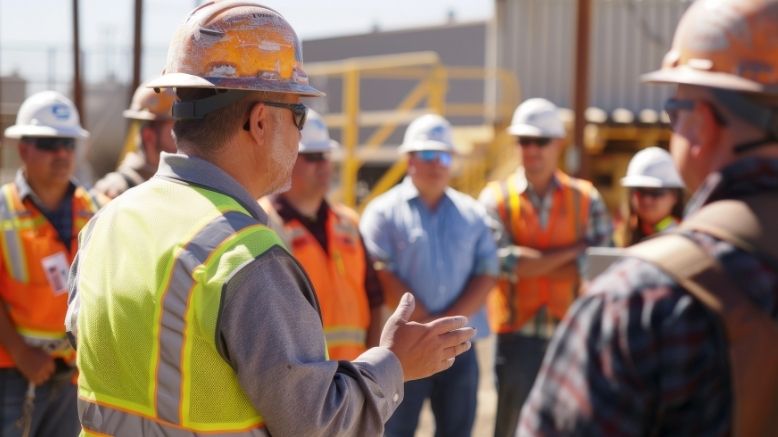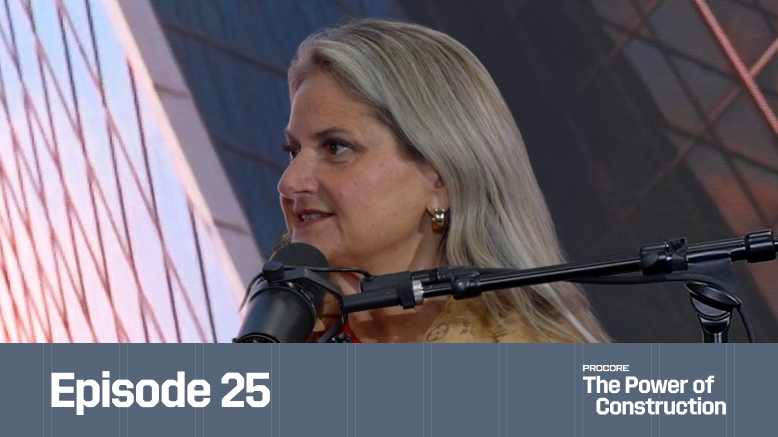— 5 min read
Future Perfect: How to Systemize Long-term Performance Forecasting


Last Updated Sep 24, 2025

Danny Stumbras
Manager, Strategic Product Consultants, Specialty Contractors
Danny Stumbras, MBA is a versatile, seasoned construction professional with a wealth of knowledge in several core areas including project management and all facets of specialty contractor trades. At Procore, Danny focuses specifically on consultant relationships and leverages his past experiences to drive recognizable value to all segments of the customer base. He earned a BA from the University of Colorado where he focused on Environmental Studies and an MBA from the University of Utah – David Eccles School of Business.

Diane McCormick
Writer
49 articles
Diane McCormick is a freelance journalist covering construction, packaging, manufacturing, natural gas distribution, and waste oil recycling. A proud resident of Harrisburg, PA, Diane is well-versed in several types of digital and print media. Recognized as one of the premier voices in her region, she was recognized as the Keystone Media Freelance Journalist of the Year in 2022 and again in 2023.
Last Updated Sep 24, 2025

From design to commissioning, useful construction forecasting lives in a continuous feedback loop, informed by changing data and results that direct refinement of systems to meet or exceed established goals. In reality, a forecast is only as good as its ability to inform future decisions.
This article explores the strategies and tools needed to embed long-term performance forecasting into operations and transform it into a tool for boosting efficiency and avoiding risks.
Table of contents
The Continuous Cycle of Forecasting
Long-term forecasting predicts how the mechanical, electrical and plumbing teams will perform over a building’s lifecycle. Results inform the design, construction and installation of systems, while also assuring owners of the ROI expected from their asset.
That makes performance forecasting a holistic pursuit. Systems and the specs provided by manufacturers are impacted by building conditions, and accurate models rely on such factors as expected and changing occupancy, climate, equipment runtime, energy consumption, maintenance and operating technology. Together, they draw a picture of the longevity and operational costs of a building and its systems.
Forecasting begins with a baseline generated from the hypotheticals of performance. From there, systematic procedures begin to measure actuals against forecasts. As real-time data is plugged in, the forecasts are revised and systems are optimized to stay on track toward established goals.
With each cycle, feedback becomes more granular and forecasts become more accurate. This continuous feedback loop informs and refines design and installation. Simulations with varied designs and optimizations show how different configurations are likely to perform in a set time period, such as 10 years.
Design and forecasting go hand in hand because this insight is allowing you to optimize things proactively long before the building is built.

Danny Stumbras
Manager, Strategic Product Consultants, Specialty Contractors
Procore Technologies
The Key Considerations of Forecasting
Strategic application of key considerations supports effective forecasting and sustains the continuous feedback loop.
System Sustainability
The holistic approach used in today’s buildings demands systems that meet sustainability standards and net-zero goals. Rising demand puts more pressure on MEP professionals to produce verifiable performance metrics. Details on every factor affecting system performance hone projections to their finest edge.
System Variability
The intermittence and variability inherent in solar and wind energy can complicate forecasts of power generation and consumption. Electrification, too, can impact dynamic load shifting, with the unpredictability of people plugging into EV chargers or heat pumps turning on. While historical data can help forecast demand spikes, the timing and magnitude of power loads can be unpredictable.
Occupant Comfort
The contributors to human-centric design are key performance indicators for modern buildings. Today’s forecasts encompass elements such as the indoor air quality, lighting and temperature controls that support the building’s operational goals for productivity, tenant retention and the overall health and comfort of the occupants.
Adjustments
The positive feedback loop starts operating when systems are running. Current performance and output provide hard data to tap for forecasts looking into the future. Based on what is known, predictions can uncover discrepancies from performance goals, allowing for adjustments that put systems on track.
Data Integration
The holistic, complete picture emerges from data points pulled from their siloes and integrated with multiple sources, such as weather, utility data, occupancy schedules, maintenance records or anything else impacting building performance.
Forecasting is essential to demonstrate that the building is going to meet its projected energy use and carbon targets. Without a granular forecast, there's a risk of a performance gap where the actual energy use is higher than expected in design. A detailed forecast helps minimize this gap by trying to account for some of those nuanced factors.
Danny Stumbras
Manager, Strategic Product Consultants, Specialty Contractors
Procore Technologies
Digital Tools for Creating & Using Forecasts
Building information modeling (BIM) is a foundational forecasting tool, with its 3D models encompassing a wealth of information and field data on components, materials, maintenance and projected and actual performance. Machine learning and algorithms can help develop future predictions by comparing historical data to real-time results.
For forecasting, BIM’s preconstruction clash detection and performance modeling generate the power to identify performance-impacting elements that might have been unpredictable or unseen otherwise.
As construction proceeds, augmented reality provides immersive reviews of complex layouts, identifying potential maintenance or access issues that could impact performance. With that knowledge, MEP professionals can improve their forecasts while removing the physical obstacles that could hamper optimal system performance and running time.
Access issues are the things that are typically a wrench in your forecast. You forecasted that you’re going to be doing certain maintenance things regularly, but then all of a sudden, you’re running into an unforeseen issue. With BIM and augmented reality, you're flagging these unforeseen issues well ahead of time.
Danny Stumbras
Manager, Strategic Product Consultants, Specialty Contractors
Procore Technologies
As much data as possible helps build forecasts based on the full spectrum of a system’s operations, but data hygiene is crucial. Clean data is inputted systematically and collected by properly calibrated sensors. It builds confidence and creates a foundation for turning the data into actionable insights for honing the forecasts and informing adjustments to the model.
The anticipated, preset factors such as occupancy and climate continue to drive the forecast, but the addition of real-time data sharpens the forecasts.
Stay updated on what’s happening in construction.
Subscribe to Blueprint, Procore’s free construction newsletter, to get content from industry experts delivered straight to your inbox.

Forecasting: A Circular Process
Strengthened forecasting fed by a constant stream of quality information becomes repetitive. Performance projections set on a continuous feedback loop cultivate a continuous improvement mindset, agile enough to respond to constant change and on the lookout for risk mitigation and operational efficiencies.
You have to highlight specific inefficiencies, potential failures and opportunities for optimization, giving your team a chance to act. It is a mindset of continuous improvement.
Danny Stumbras
Manager, Strategic Product Consultants, Specialty Contractors
Procore Technologies
The feedback loop of projections creates a living record of system performance. When a system’s actual performance can be elevated to achieve aspirational levels, the forecast not only predicts the future but helps assure a building’s comfort, sustainability and longevity.
Was this article helpful?
Thank you for your submission.
0%
0%
You voted that this article was . Was this a mistake? If so, change your vote
Scroll less, learn more about construction.
Subscribe to The Blueprint, Procore’s construction newsletter, to get content from industry experts delivered straight to your inbox.
By clicking this button, you agree to our Privacy Notice and Terms of Service.
Thank you!
You’re signed up to receive The Blueprint newsletter from Procore. You can unsubscribe at any time.
Categories:
Written by

Danny Stumbras
Manager, Strategic Product Consultants, Specialty Contractors | Procore Technologies
Danny Stumbras, MBA is a versatile, seasoned construction professional with a wealth of knowledge in several core areas including project management and all facets of specialty contractor trades. At Procore, Danny focuses specifically on consultant relationships and leverages his past experiences to drive recognizable value to all segments of the customer base. He earned a BA from the University of Colorado where he focused on Environmental Studies and an MBA from the University of Utah – David Eccles School of Business.
View profile
Diane McCormick
Writer | Procore Technologies
49 articles
Diane McCormick is a freelance journalist covering construction, packaging, manufacturing, natural gas distribution, and waste oil recycling. A proud resident of Harrisburg, PA, Diane is well-versed in several types of digital and print media. Recognized as one of the premier voices in her region, she was recognized as the Keystone Media Freelance Journalist of the Year in 2022 and again in 2023.
View profileExplore more helpful resources

Profit from Predictability: Construction Software as a Business Strategy
For general contractors, managing complex, multi-million-dollar projects, every project phase — from planning and budgeting to on-site execution — is an opportunity to lose time and money. Construction software is...

Defending Against Financial & Legal Risks on Megaprojects
The construction industry has seen marked growth in megaprojects. Some experts classify any project over $500 million as a megaproject, while others argue that the build needs to be $1...

Unlocking Project Intelligence: Moving from Raw Data to Actionable Insights
The construction industry faces a wide range of challenges, from ongoing labor shortages to frequent cost overruns. But some the biggest hurdles all stem from unpredictability. The general contractors (GCs)...

Who is accountable for innovation in construction?
Everyone says construction needs to innovate—but no one agrees on who’s actually responsible for making it happen. Is it the owner? The builders? The tech vendor? Or is innovation everyone’s...
Free Tools
Calculators
Use our calculators to estimate the cost of construction materials for your next project.
Templates
Find a template to help you with your construction project tasks.
Material Price Tracker
Get the latest U.S. retail prices and view historical trends for common building materials.
Glossary
Explore key terms and phrases used in the industry.
